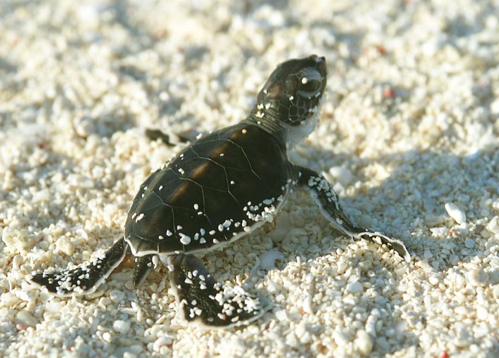Climate change could have some devastating effects on the reproductive mechanisms of certain marine organisms.
Often, change in temperature signals to some species that the time is right for reproduction. Rising sea water temperature will thus alter the reproductive behavior of some marine life.
Research has shown that in warmer water krill have significantly lower levels of reproduction. This could have long-term consequences on the species that eat krill as their main food source, such as penguins, and the predators of those species, such as seals.
In specific marine reptiles, such as sea turtles, the sex of the hatchlings is determined by the ambient temperature of the nest environment. This is called temperature-dependent sex determination. Certain studies show that the gender ratios of sea turtles have already been affected by climate change. According to Science Daily, 90% of hatchlings in Florida are female, while, in North Carolina, 42% of hatchlings are male. Scientists believe that males, once mature, travel south to breed, which could potentially contribute to gene flow. Researchers are "concerned that populations that are already predominantly female could become 100% female if temperatures increase by just one degree."
In specific marine reptiles, such as sea turtles, the sex of the hatchlings is determined by the ambient temperature of the nest environment. This is called temperature-dependent sex determination. Certain studies show that the gender ratios of sea turtles have already been affected by climate change. According to Science Daily, 90% of hatchlings in Florida are female, while, in North Carolina, 42% of hatchlings are male. Scientists believe that males, once mature, travel south to breed, which could potentially contribute to gene flow. Researchers are "concerned that populations that are already predominantly female could become 100% female if temperatures increase by just one degree."
A recent study done on a population of leatherback sea turtles shows how climate change, both on land and in the oceans, can affect the reproductive patterns of marine organisms. Studies of individual populations are especially helpful when studying the reproductive effects of climate change and are also helpful when studying adaptation of marine life in general.


Here's a green sea turtle hatchling. So cute!
For more information about sea turtles, visit the Georgia Sea Turtle Center's website. Or, if you ever get the time, you should really go to the center itself on Jekyll Island.
In addition to ectotherms, climate change has been shown to have distinct effects on the larval maturation rates and morphologies in certain species, including sea urchins (Runcie et al.). Urchins that were subjected to higher temperatures were significantly shorter along their animal-vegetal axis. The scientists hypothesized that this decrease in size was because of the increased metabolic demands of development at higher temperatures. The embryos also had less ordered cells in their ectoderms. However, the embryos at the higher temperatures developed through the gastrula stage, which suggests that the embryos were able to buffer their development against temperature stress. These results, however, should not be very surprising. This species has a very large effective population size, high genetic variation, and an extensive gene flow among different populations living in widely varying temperature ranges. Species with smaller effective population sizes and lower genetic variation will have more devastating effects on their ability to reproduce.
Fish are also likely to experience changes in their reproductive patterns as a result of the onset of climate change. These changes may range from affecting in what geographical regions fish are able to spawn to how many eggs fish are able to spawn to not being able to reproduce at all. This paper explores the many influences that the rising temperature of the seas has on the reproduction of fish.

Eggs, like any other living organism, can only survive in certain temperature ranges. As the temperature of the seas increases, fish will react by moving where they lay their eggs, ceasing to spawn eggs, or spawning as usual, giving the eggs a chance to adapt, acclimate, or die.
/groups/evolution3000/search/index.rss?sort=modifiedDate&sortDirection=reverse&tag=adaptationlist/groups/evolution3000/search/?sort=modifiedDate&sortDirection=reverse&tag=adaptationAdaptationCustomTagSidebarCustomTagSidebar?sort=modifiedDate&sortDirection=reverse&tag=adaptation0/groups/evolution3000/sidebar/CustomTagSidebarmodifiedDate5CustomTagSidebarreverseadaptationAdaptationcustom/groups/evolution3000/search/index.rss?tag=hotlist/groups/evolution3000/search/?tag=hotWhat’s HotHotListHot!?tag=hot1/groups/evolution3000/sidebar/HotListdheubel5dheubel52012-11-14 16:36:03+00:002012-11-14 16:36:03updated5dheubel5dheubel52012-11-09 16:46:53+00:002012-11-09 16:46:53updated4Added tag - hotdheubel5dheubel52012-11-09 16:46:49+00:002012-11-09 16:46:49addTag3I thought this might be helpful in reading through everything. Let me know if you guys like it!dheubel5dheubel52012-11-09 16:46:24+00:002012-11-09 16:46:24updated2First createddheubel5dheubel52012-11-09 16:31:49+00:002012-11-09 16:31:49created1wiki2012-11-14T16:36:03+00:00groups/evolution3000/wiki/de98eFalseTable of Contents/groups/evolution3000/wiki/de98e/Table_of_Contents.htmldheubel55 updatesTable of Contents
Climate Change
Effects of Climate Change in the Environment
Oxygen Levels
Effects o...Falsedheubel52012-11-14T16:36:03+00:00hot/groups/evolution3000/search/index.rss?sort=modifiedDate&kind=all&sortDirection=reverse&excludePages=wiki/welcomelist/groups/evolution3000/search/?sort=modifiedDate&kind=all&sortDirection=reverse&excludePages=wiki/welcomeRecent ChangesRecentChangesListUpdates?sort=modifiedDate&kind=all&sortDirection=reverse&excludePages=wiki/welcome0/groups/evolution3000/sidebar/RecentChangesListmodifiedDateallRecent ChangesRecentChangesListUpdateswiki/welcomeNo recent changes.reverse5search
Comments
john wares
Sep 26, 2012
that IS cute. can somebody start expanding on the effects on reproduction, we have dealt with this a lot in recent papers in terms of larval development. OR, this page (first line, anyway) could link to pages where we deal with those things. we are weaving a web!